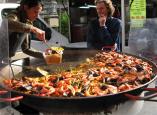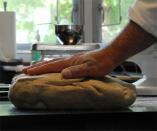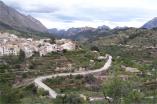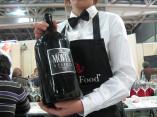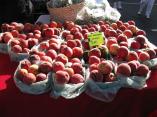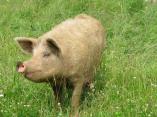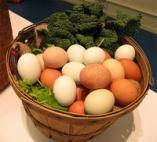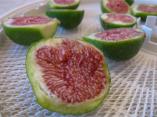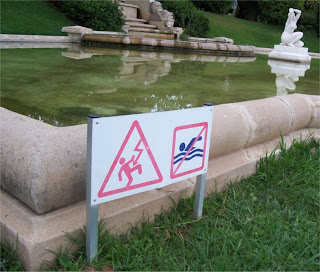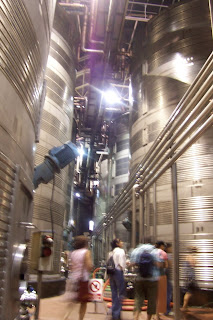Reports, exams and internet problems have been interfering with this blog. More to come on Spain, but maybe not for a couple of days. Meanwhile, back in Parma…
We are counting down now. Ten more days of classes and we’re done, ready to scatter for the summer and then for two months of internships.
Odd to think that after months and months of constant contact we won’t be seeing one another until graduation in November. Good and bad it’s been, and I when I heard Leonard Cohen talking about monastic life in a recent BBC interview, it struck a chord:
“People think of this activity as somehow remote, isolated and serene, whereas it’s much more abrasive than ordinary civilian life. In ordinary civilian life you close your doors at the end of the day and more or less you’re alone with your television set, but in a monastery.. there’s a zen saying: like pebbles in a bag, the monks polish one another.“
We are, I think, well polished gastro-pebbles by now.
It’s been a steamy week in Parma with the temperature set to rise and rise into next week; I can’t say I’ll miss the weather here (damp and cold in the winter; hot and humid in the summer, just the way the prosciutti like it). Nor will I miss my visits to supermercato Standa, where you can enjoy spiritual debasement with the rest of the long-suffering Oltretorrentini: standing in long, tedious queues which may randomly end with a terse “E chiuso” from the attending demon, at which point we all shuffle into another long, dispirited queue, and are then hectored into giving up complicated combinations of coins because from all appearances the check-out cashiers are charged for their change floats.
So here we melt. By night we toss in our hot rooms, only to rise welted and itchy from insect bites: spiders, mosquitoes, who knows. To judge by the volume of chittering along the river, the frogs are doing their best to control the numbers; the rondini (swallows) who took on the springtime airborne have all left for what I assume are cooler climates. There’s an abandoned bird nest in the air vent in our kitchen that only coughs a bit of dust on the floor these days, no more face to face confrontation with the parents who for a couple of weeks hovered fiercely at the window, moths in beak, to demand what we were doing so near their home.
This week, several of those who didn’t fall to Spanish ailments began to drop, and our numbers were reduced by nearly half for most of our classes. The end of Consumption Psychology: no more than a recap really of what we talked about before we left for Spain – who we are and our social circumstances influence what we eat and how we think about food – nothing too new there. Then Sociology of Food Consumption, where we talked about branding and advertising techniques as applied to food. Mostly it felt like a depressing recount of mergers and aquisitions among the likes of PepsiCo and Coca-Cola, with less to do with artisanal brands or alternative markets. Then we had two delightful final tastings with Sandro Bosticco, who led us through discussions about the role of oxygen in winemaking, with a finale that featured four Pinot Noirs (three from Burgundy and one from New Zealand) and then group tastings of sparkling (Prosecco), red (Amarone) and sweet (Moscato – passito) wines.
Friday we got on our stage bus for the last time, leaving behind a host of fallen comrades (some suffering from late-breaking flu and others perhaps from a mild case of Friday nightis), to study balsamic vinegar production from industrial prosciutto makers Ferrarini, who as a family have the slightly surprising hobby of artisanal vinegar making. As balsamico derives its name from ‘balsam’ – as in healing substance – it was a shame we couldn’t all be there to breathe the purifying perfumes, and taste the rapture, spoon by blessed spoon.
We learned about the rather lax standards for the substance known as Aceto Balsamico di Modena (“Modena Balsamic Vinegar”) – which require that it be of a minimum acidity of 6%, made from grape must (minimum 20%) and vinegar, caramel (maximum 2%, for colour and flavour), with a minimum 60 days aging. Ferrarini make a higher quality product which is aged a minimum of 8 to 10 years, but on the grocery shelf, consumers won’t understand the difference (other than price) when it’s ranked against the lower end products. This version is the balsamico you use for cooking and salad dressings. The more precious condiment is another story entirely.
What we may think we’re getting when we see the words balsamico and Modena and vinegar on a label is in fact correctly known as Tradizionale Balsamico, and there are two strains of it, one from Reggio-Emilia and one from Modena, made in more or less the same way but with a different balance of density and acidity, and bottled in different areas. They also have different quality standards: there are three quality levels for Tradizionale Balsamico di Reggio Emilia (red, silver and gold) and two for Tradizionale Balsamico di Modena. This is the highest end product, a thick, sticky goo that takes at least 12 years to make and should be doled out by the drop, as a condiment on strawberries or parmigiano-reggiano cheese, or even drunk from thimble-sized glasses after a meal or, according to Anna del Conte, diluted with ice and sweetened with a little sugar.
Before you get to that point, though, the stuff has to be made. According to tradition and regulation, it’s made only from grape must: local grapes are crushed and cooked until the volume has reduced by 50-60%, leaving a high density, sweet syrup. It’s fermented in barrels with only natural yeasts (present in air or the grapes themselves) for company. At the end of the year it will have reached about 6 or 7% alcohol, with lots and lots of residual sugars. A small quantity of older balsamico is added, containing live bacteria, and another two years or so go by while these bacteria carry out the acidification process which transforms the alcohol into acid.
Then the real fun begins, when it’s decanted into a series of barrels of diminishing size, made of different woods: chestnut, oak, ash, mulberry, cherry and locust wood, which all add different flavours. There will be at least three but not more than ten casks, which are not sealed, the opening on the top covered with muslin to allow the liquid to thicken through evaporation. They are stored in vaults where the local climate can play its part: the cold winters concentrating the flavours, the hot summers evaporating the water content.
The barrels lose about a litre a year, so they are topped up in a formal process: the smallest barrel gets a litre from the next largest; that one gets two litres from its neighbour, and so on up the chain until the largest barrel receives about 30 to 40% newly acidified balsamico. This chain continues for between 12 and 25 years, at which point between 5-10% of the smallest barrel’s content is decanted and sent to the consortium for testing.
The consortium determines which of the three levels the balsamico will be sold as. These are related to age, but not completely determined by it, as the tasting is the final arbiter. The “lobster red” labelled balsamico is at least 12 years old; the silver is 12-25 years; and the gold is at least 25 years old.
Because vinegar is a preservative, once you’ve invested your money (at least 30 euros for the red label, and upwards of 75 euros for the gold – in Italy; more if you buy it in other countries), you won’t ever have to worry about it going off (perhaps you’d like to pass a bottle down to your grandchildren?). It does behave much like honey though, and has a tendency to crystallise; but, like honey, it can be restored to liquid state by gently heating the bottle in water.
We got back to sticky Parma in time to rest up before supper. A group of us went to see chef Davide at Ristorante Mosaiko and ate ourselves into a happy stupour, with my favourites being an outstanding guinea fowl salad, dreamy gnocchetti topped with amazing mozzarella, and an even better than last time slice of bonet for dessert. I’m still digesting today…
